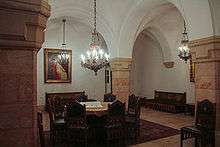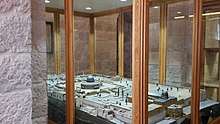Paulus-Haus
The Paulus-Haus is a pilgrim hospice in Jerusalem under the care of the German Association of the Holy Land. It is situated on the Nablus Road in the Eastern part of the historical old city, directly against the Damascus Gate. The monumental architecture is reminiscent of the crusader castles.[1]

History

At the end of the 19th century, there were already numerous Germans going on organised pilgrimages to Jerusalem, some offered by the recently merged German Association of the Holy Land, founded in 1885. Since 1866 there has been a small guest house for German pilgrims close to the Jaffa Gate. At a meeting with the German Kaiser Wilhelm II during his travels through Palestine in 1898, the German Lazarist Friedrich Wilhelm Schmidt suggested building a new bigger and more suitable accommodation for pilgrims.[2] The Kaiser had already supported the construction of the Lutheran Church of the Redeemer and the establishing of the Abbey of the Dormition on Mount Zion. With his support, the German Association of the Holy Land successfully acquired two parcels in the immediate vicinity of the Damascus Gate in 1899.[3] The pilgrim hospice project was taken on by the architect of the Roman Catholic Archdiocese of Cologne, Henrich Renard, who was also responsible for building the Abbey of the Dormition and the Dormitio Church on Mount Zion at the same time. The first foundation stone was laid on 20 March 1904. In 1908 the Saint Paul Hospice was opened and entrusted to the Catholic Sisters of St. Carl Borromaeus. It offered space for approximately 160 guests and it quickly became a much beloved place among German pilgrims on their way to Jerusalem.[4]
Due to the outbreak of the First World War and the consequent halting of organised pilgrimages, the Paulus-Haus was closed and for a short time used as a headquarters and recuperation facility for German soldiers.[5]
After the collapse of the Ottoman Empire, Jerusalem came under the control of the British Mandate of Palestine and became the seat of the high commissioner and the mandate administration. The Paulus-Haus was seized by the British Armed Forces and used as a general consulate until 1948.[6] When the British mandate ended, the building was returned to the German Association of the Holy Land and as a result of the division of Jerusalem after the Palestine War, the Paulus-Haus now lay in the Jordanian half of Jerusalem.[7]
Due to the military action, the activity of the Schmidt's Girls College was interrupted and the school, housed in the Paulus-Haus since 1886, was moved into a newly constructed building adjacent to it in 1965. Since then, the Paulus-Haus has resumed its role as a pilgrim accommodation and from 1989 onwards, along with the Schmidt’s Girls College, has been entrusted to the international convent of the Sisters of the Congregation of Jesus.
Layout

The Kaisersaal (King's Chamber) in Paulus-Haus has been preserved with its original layout and donated furniture from the time of Kaiser Wilhelm II.[8]
The museum of the German Association of the Holy Land has two archaeological finds from the time of Christ on display, as well as items connected to the history of the Association and two models of the Temple Mount. The museum was opened at the beginning of the 1990s in the basement of the Paulus-Haus.[9]
The rooftop terrace offers a sweeping view over the Old City of Jerusalem between the Mount of Olives, Temple Mount, Mount Zion and the Church of the Holy Sepulchre.
Schmidt's Girls College
The Schmidt’s Girls College is a German international school for Christian and Muslim girls. It was founded in 1885 and provides primary and secondary education to approximately 500 pupils.
Webpages
- Paulus-Haus on the German Association of the Holy Land website
References
- Erich Läufer: 100 Jahre Paulus-Haus in Jerusalem: Der Deutsche Verein vom Heiligen Lande feiert sein historisches Gästehaus. In: Katholische Kirchenzeitung Berlin. 5. Dezember 1999, abgerufen am 6. Dezember 2014.
- Erich Läufer: 100 Jahre Paulus-Haus in Jerusalem: Der Deutsche Verein vom Heiligen Lande feiert sein historisches Gästehaus. In: Katholische Kirchenzeitung Berlin. 5. Dezember 1999, abgerufen am 6. Dezember 2014.
- Erich Läufer: 100 Jahre Paulus-Haus in Jerusalem: Der Deutsche Verein vom Heiligen Lande feiert sein historisches Gästehaus. In: Katholische Kirchenzeitung Berlin. 5. Dezember 1999, abgerufen am 6. Dezember 2014.
- Erich Läufer: 100 Jahre Paulus-Haus in Jerusalem: Der Deutsche Verein vom Heiligen Lande feiert sein historisches Gästehaus. In: Katholische Kirchenzeitung Berlin. 5. Dezember 1999, abgerufen am 6. Dezember 2014.
- Erich Läufer: 100 Jahre Paulus-Haus in Jerusalem: Der Deutsche Verein vom Heiligen Lande feiert sein historisches Gästehaus. In: Katholische Kirchenzeitung Berlin. 5. Dezember 1999, abgerufen am 6. Dezember 2014.
- Erich Läufer: 100 Jahre Paulus-Haus in Jerusalem: Der Deutsche Verein vom Heiligen Lande feiert sein historisches Gästehaus. In: Katholische Kirchenzeitung Berlin. 5. Dezember 1999, abgerufen am 6. Dezember 2014.
- Erich Läufer: 100 Jahre Paulus-Haus in Jerusalem: Der Deutsche Verein vom Heiligen Lande feiert sein historisches Gästehaus. In: Katholische Kirchenzeitung Berlin. 5. Dezember 1999, abgerufen am 6. Dezember 2014.
- Erich Läufer: 100 Jahre Paulus-Haus in Jerusalem: Der Deutsche Verein vom Heiligen Lande feiert sein historisches Gästehaus. In: Katholische Kirchenzeitung Berlin. 5. Dezember 1999, abgerufen am 6. Dezember 2014.
- "Kein frommes Hobby": Kardinal Meisner eröffnet Museum des Heilig-Land-Vereins. In: domradio.de. 26. Januar 2013, abgerufen am 6. Dezember 2014